Bento
A bento (弁当, bentō)[1] is a single-portion take-out or home-packed meal of Japanese origin. Outside Japan, it is common in Chinese, Taiwanese and Korean cuisines, as well as in Southeast Asian cuisines where rice is the main staple food. A traditional bento may contain rice or noodles with fish or meat, often with pickled and cooked vegetables in a box.[2] Containers range from mass-produced disposables to hand-crafted lacquerware. Bento are readily available in many places throughout Japan, including convenience stores, bento shops (弁当屋, bentō-ya), railway stations, and department stores. However, Japanese homemakers often spend time and energy on carefully prepared box lunches for their spouses, children, or themselves. Bentos can be elaborately arranged in a style called "kyaraben" ("character bento"), which are typically decorated to look like popular characters from Japanese animation (anime), comic books (manga), or video games. Another popular bento style is "oekakiben" or "picture bento". This is decorated to look like people, animals, buildings and monuments or items such as flowers and plants. Contests are often held where bento arrangers compete for the most aesthetically attractive arrangements.

There are somewhat comparable forms of boxed lunches in East Asian countries including mainland China and Taiwan (biàndāng in Mandarin and "piān-tong" in Taiwanese Hokkien) and Korea (dosirak), and in Southeast Asian countries such as the Philippines (baon) and Thailand (pin-tou). Hawaiian culture has also adopted localized versions of bento featuring local tastes after over a century of Japanese influence.
There has also been discussion regarding what the bento means for Japanese society and what it represents. The analyses range from a simple semiotic approach to one that outlines the deeper ideological meanings behind the bento.
Etymology
In Japan, "bento" is written as 弁当. The word originates from the Southern Song slang term 便当 (便當 (pinyin: biàndāng)), meaning "convenient" or "convenience". When imported to Japan, it was written with the ateji 便道 and 弁道.[3][4] The word "bento" has been used since the 13th century, and the container itself, also called "bento", has been known since the 16th century.[3] In modern times, bento is commonly used in Western countries and East Asia. In mainland China, Hong Kong and Taiwan, "bento" is written as 便當 (pinyin: biàndāng).
History
The origin of bento can be traced back to the 12th century during the Kamakura period, when cooked and dried rice called hoshi-ii (糒 or 干し飯, literally "dried meal") was developed, to be carried to work.[2] Hoshi-ii can be eaten as is or boiled with water to make cooked rice, and is stored in a small bag. By the 16th centhury, wooden lacquered boxes were produced, and bento would be eaten during a hanami or a tea party.
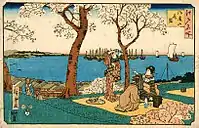
In the Edo period (1603–1867), bento culture spread and became more refined. Travelers and sightseers would carry a simple koshibentō (腰弁当, "waist bento"), consisting of several onigiri wrapped with bamboo leaves or in a woven bamboo box. One of the most popular styles of bento, called makuno-uchi bentō ("between-act bento"), was first made during this period.[5] People who came to see Noh and Kabuki ate specially prepared bentos between maku (acts). Numerous cookbooks were published detailing how to cook, how to pack, and what to prepare for occasions like hanami and Hinamatsuri.
In the Meiji period (1868–1912), the first ekibentō or ekiben (駅弁当 or 駅弁, "train station bento") was sold. There are several records that claim where ekiben was first sold, but it is believed that it was sold on 16 July 1885, at the Utsunomiya train station, in the northern Kantō region of Japan, and contained two onigiri and a serving of takuan wrapped in bamboo leaves. As early schools did not provide lunch, students and teachers carried bentos, as did many employees. European style bentos with sandwiches also went on sale during this period.
In the Taishō period (1912–1926), the aluminum bento box became a luxury item because of its ease of cleaning and its silver-like appearance. Also, a move to abolish the practice of bento in school became a social issue. Disparities in wealth spread during this period, following an export boom during World War I and subsequent crop failures in the Tohoku region. A bento too often reflected a student's wealth, and many wondered if this had an unfavorable influence on children both physically, from lack of adequate diet, and psychologically, from a clumsily made bento or the richness of food. After World War II, the practice of bringing bentos to school gradually declined and was replaced by uniform food provided for all students and teachers.[6]

Bentos regained popularity in the 1980s, with the help of the microwave oven and the proliferation of convenience stores. In addition, the expensive wood and metal boxes have been replaced at most bento shops with inexpensive, disposable polystyrene boxes. However, even handmade bentos have made a comeback, and they are once again a common, although not universal, sight at Japanese schools. Bentos are still used by workers as a packed lunch, by families on day trips, as well as for school picnics and sports days. The bento, made at home, is wrapped in a furoshiki cloth, which acts as both bag and table mat.
Taiwan
The bento made its way to Taiwan in the first half of the 20th century during the Japanese colonial period and remains popular to the present day.[7] The Japanese name was borrowed as bendong (Taiwanese: piān-tong) or Mandarin biàndāng (便當).[8] Taiwanese bento always includes protein, such as a crispy fried chicken leg, a piece of grilled mackerel and marinated pork chop, as well as the side dishes.[7]
Korea
In Korea, the packed lunch boxes are called Dosirak (also spelled "doshirak") and they are either made at home or bought at the store. They are similar to Japanese bento but slightly different. Korean bento boxes are usually made with a few different vegetable and meat side dishes. The special ingredient is Kimchi which adds the Korean element to the bento box.[9]
Culture
In Japan, it is common for mothers to make bento for their children to take to school. Because making bento can take a while, some mothers will prepare the ingredients the night before, and then assemble and pack everything the following morning before their children go to school.[10] It is often a social expectation of mothers to provide bento for their children, to create both a nutritionally balanced and aesthetically pleasing meal.[11] This activity is expected of the mother and emphasized by society at large,[11] and is common in nursery school institutions.
The traditional bento, which is eaten at school or at work; prepared by the mother or the wife. It can also be bought in konbini (mini-markets) or from street vendors who appear on street corners at lunchtime. For those in a hurry who have to spend their lunch time aboard the shinkansen, there is also the bento ekiben which, as its name suggests, is on sale in the train stations. Bento is also present in more solemn moments, even on the Japanese New Year's table for example. Then called osechi, it comes in two or three levels and contains expensive dishes that are eaten at this high point of the Japanese calendar.[12]
Interpretations of Bento
Many scholars have had a take on the bento in the late 20th century. The foundation of their approach is based on the idea that food can carry many different meanings.[13]
In the 1970’s, Chie Nakane used the ekiben, a specific type of bento sold in train stations, as a metaphor for group organization in Japan. By comparing this variant of bento to groups in Japan, he considered how different organizations in Japanese society often include identical components so it does not depend on any other groups for its success.[13] For O-Young Lee in 1984, the bento is utilized to present the reductionism tendencies of Japanese culture. All the food in this Japanese style lunch box is only able to be reduced to fit in a little box due to it being Japanese food; it naturally lends itself to being tightly packed.[14] Roland Barthes, on the other hand, used a symbolic approach to describe the lack of a centerpiece in Japanese food. He described the distinct contents of a bento box as a multitude of fragments or ornaments that are thrown together to beautify each other.[15] Joseph Jay Tobin in 1992 discussed how the meticulous assembly of individual bentos has been aided by the reinterpretation of Western goods, practices, and ideas through a process he classified as domestication.[16]
Bento and the ideological state apparatus
In 1991, Ann Allison gives an interpretation of the obento, another variant of the bento, as an “ideological state apparatus” that is a conduit for motherhood, education, and the state[13] in her book Permitted and Prohibited Desires: Mothers, Comics, and Censorship in Japan. She has stated that the mother, who is the producer of the obento, and the child, who is the consumer, are both under heavy scrutiny by the institutions surrounding them. Thus, their roles in society are further cemented through the ideological and gendered meanings embedded with the obento.[11]
The basis for Allison’s argument is from a concept created by Louis Althusser. The idea behind an ideological state apparatus is that they are able to exert power through ideology through items like mass media and education rather than through repression.[17] The ideology becomes effective as it manifests into one’s identity instead of it remaining as an outside thought.[11]
Allison structures her thoughts into three sections, with the first being an investigation of Japanese food as a cultural myth. She presents old Japanese obento magazines and journals that describe concerns on the strains that the obento puts on the mother and the child which segue into her point that the significance of this Japanese lunch box goes much deeper than that of mere sustenance which is appoints as the first-order myth.[11] Since one of the codes regarding the presentation of Japanese food emphasizes the look of naturalness over genuine naturality,[18] Allison articulates that this is how Japanese food can be subject to cultural and ideological manipulation. This is where it becomes a second-order myth as the practice of the obento is able to serve a different end. As a result, she takes the presence of an order to the food to suggest a fundamentally correct way to do things in society.[11]
Allison builds upon the previous statements and presents a third order that deals with manipulation and the rituals surrounding the obento: the school system instills the routine with the obentos in order to assimilate the mothers and their children to the gendered roles that are expected of them by the state.[11] It is believed that schools shape children’s views on the world and that the rules and patterns of group living in Japan are introduced to a child starting in nursery school. As a result, the obento becomes a test for the child as finishing the entire obento in a timely manner is encouraged and enforced by the nursery school teacher.[11] Furthermore, the successful integration into the Japanese school system can be seen to depend on the child’s deference to authority and learned knowledge to obey rules through the obento practice. Even if a child is caught misbehaving in school, the teacher may describe the child’s progress on his or her obento instead of directly referencing the wrongdoing that was committed.[11]
This discussion wraps up by relating motherhood to the obentos. A child would not be able to take an obento to school without the labor of the mother. On average, mothers spend anywhere from twenty-five to forty-five minutes every morning preparing their child’s obento and even more time is dedicated to preparing on the previous day.[11] Allison interprets this as a sign of a woman’s commitment to being a mother which in turn should influence her child to be a good student. It is taken one step further by explaining the experience of making the obento becomes a part of the mother’s identity.[11] As this process starts at the nursery school level, Allison determines that motherhood becomes institutionalized through the child’s school. This means that the obento is not only a test for the child, but it also becomes a representation and product of the mother herself.[11]
Types
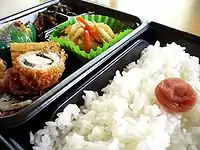

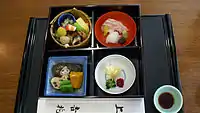
- Chūka bentō (中華弁当) are filled with Chinese food and often used as an appetizer or a midnight "snack".
- Hinomaru bento (日の丸弁当) is the name for a bento consisting of plain white rice with an umeboshi in the centre. The name was taken from the Hinomaru, the Japanese flag, which has a white background with a red circle in the centre. Pure Hinomaru bento only consists of rice and umeboshi to flavor rice without any other side dishes. The metal bento boxes, once popular in Japan, were often corroded by the acid of umeboshi, eventually making a hole in the middle of the lid.
- Kamameshi bentō (釜飯弁当) are sold at train stations in Nagano Prefecture. It is cooked and served in a clay pot. The pot is a souvenir item.
- Makunouchi bentō (幕の内弁当) is a classic style of bento with rice, umeboshi, a slice of broiled salmon, and a rolled egg.
- Sake bentō (鮭弁当) is a simple bento with a slice of broiled salmon as the main dish.
- Shidashi bentō (仕出し弁当) is made in a restaurant and delivered during lunch. This bento is often eaten at a gathering like a funeral or a party. It is usually packed with traditional Japanese foods like tempura, rice and pickled vegetables. A shidashi bento packed with European-style food is also available.
- Shōkadō bentō (松花堂弁当) is a traditional black-lacquered bento box. It inspired IBM's (later sold to Lenovo) ThinkPad design.[19]
- Tori bento (鳥弁当) consists of pieces of chicken cooked in sauce served over rice. It is a popular bento in Gunma Prefecture.
- Kyaraben (キャラ弁) is a bento with the contents arranged to look like popular characters from anime, manga, or video games.
- Shikaeshiben (仕返し弁) is a "revenge" bento where wives make bentos to get back at their husband by writing insults in the food or making the bento inedible.[20]
Other
- Ekiben (駅弁) is a bento sold at railway stations (eki) or onboard trains. There are many kinds of ekiben. Most are inexpensive and filling.
- Hayaben (早弁), literally "early bento", is eating a bento before lunch and having another lunch afterward.
- Hokaben (ホカ弁) is any kind of bento bought at a take-out bento shops. Freshly cooked hot (hokahoka) rice is usually served with freshly prepared side dishes. The name was popularized after a pioneering take-out bento franchise in the field, Hokka Hokka Tei.
- Noriben (海苔弁) is nori dipped in soy sauce covering cooked rice.
- Soraben (空弁) is a bento sold at airports.
Gallery
 An oekakiben containing rice balls decorated to resemble pandas
An oekakiben containing rice balls decorated to resemble pandas A set of stacking boxes for bento called jūbako
A set of stacking boxes for bento called jūbako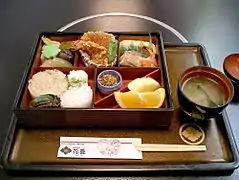 Bento served at a restaurant in Japan
Bento served at a restaurant in Japan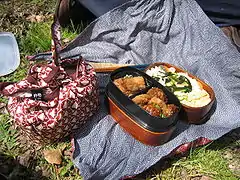 Two typical home made bento (one open, one wrapped); note the furoshiki cloths
Two typical home made bento (one open, one wrapped); note the furoshiki cloths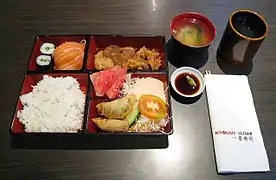

 Orizume bentō (1)
Orizume bentō (1)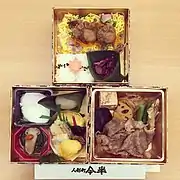 Orizume bentō (2)
Orizume bentō (2)
References
- "Bento". Dictionary.com.
- "Bento: Changing New York's Lunch Culture," Chopsticks NY, vol. 27, July 2009, p. 10-11.
- Bento 弁当(べんとう) 語源由来辞典 (Etymology Dictionary)
- Bento (Lunch Box), Japan Hoppers, Retrieved on 29 May 2017
- "Japanese Lunch Boxes - History". web-japan.org. Kids Web Japan. Retrieved 9 December 2013.
- Buck, Stephanie (2016-09-09). "The controversial history of the bento box". Medium. Retrieved 2019-10-01.
- Chen, Karissa (2019-03-06). "Taiwan's Train Food Puts Amtrak to Shame". Eater. Retrieved 2019-06-05.
- Hiufu Wong, Maggie. "40 of the best Taiwanese foods and drinks". edition.cnn.com. CNN. Retrieved 8 April 2020.
- "Korean lunchbox recipes from Cooking Korean food with Maangchi". www.maangchi.com. Retrieved 2020-12-13.
- Siegel, Bettina. "The Adorable Lunch, Part 2: My Interview With Bento Moms". The Lunch Tray. Retrieved 13 December 2016.
- Allison, Anne (2000). Permitted and Prohibited Desires. Berkeley, California: University of California Press. pp. 81–104.
- "What is the origin of bento?". Bento-cook. Retrieved 2020-04-24.
- Noguchi, Paul H. (1994). "Savor Slowly: Ekiben: The Fast Food of High-Speed Japan". Ethnology. 33 (4): 317. doi:10.2307/3773902. ISSN 0014-1828.
- Yi, Ŏ-ryŏng, 1934- (1984). Smaller is better : Japan's mastery of the miniature (1st English ed.). Tokyo: Kodansha International. ISBN 0-87011-654-1. OCLC 10723642.CS1 maint: multiple names: authors list (link)
- Barthes, Roland. Empire of signs. Howard, Richard (First American ed.). New York. ISBN 0-8090-4222-3. OCLC 8587789.
- Re-made in Japan : everyday life and consumer taste in a changing society. Tobin, Joseph Jay. New Haven: Yale University Press. 1992. ISBN 0-300-05205-7. OCLC 25048328.CS1 maint: others (link)
- Althusser, Louis. On the reproduction of capitalism: ideology and ideological state apparatuses. London. ISBN 978-1-78168-165-7. OCLC 842880762.
- Richie, Donald. A taste of Japan: food fact and fable : what the people eat : customs and etiquette (First ed.). Tokyo. ISBN 0-87011-675-4. OCLC 11533245.
- Golden, Peter (January 1, 1999). "Big Blue's big adventure". EDN. Archived from the original on June 20, 2012. Retrieved 2007-03-24.
- "Revenge bento show us it's a dish best served cold (and boxed) with insults and hidden chilies". SoraNews24. 2015-02-28. Retrieved 2017-07-11.